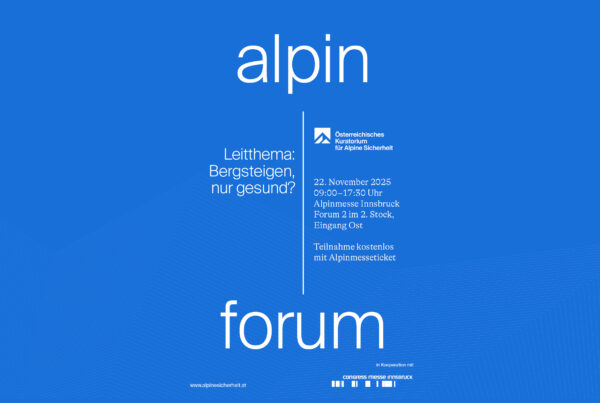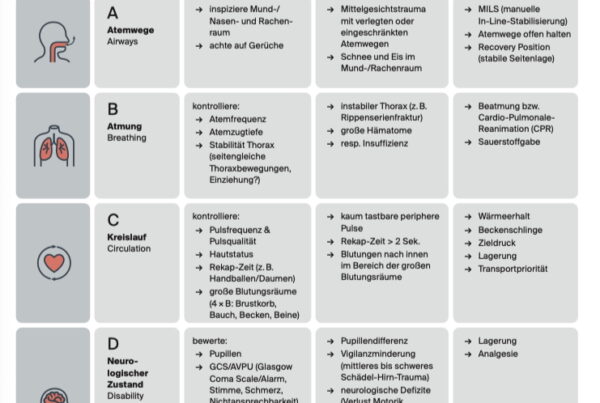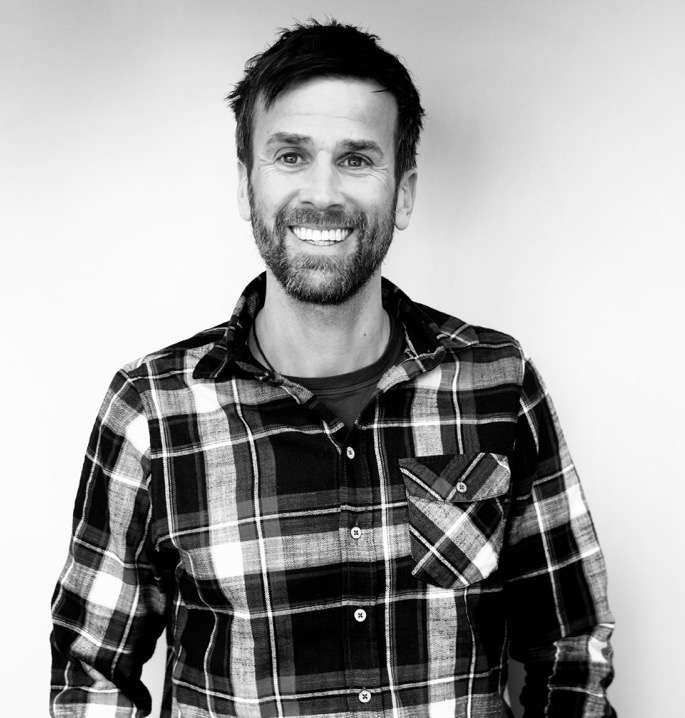
This interview was published in the winter 2024/25 issue of the ÖKAS trade magazine analyse:berg, which is hot off the press!
Become a subscriber to analyse:berg. You will receive the magazines conveniently delivered to your home as soon as they are published and support the work of the ÖKAS at the same time.
Helping to shape motivates!
Interview with Jörg Randl, new head of the mountain sports department at the ÖAV
From competitive athlete to trainer and instructor to police and civilian mountain guide – his life has always revolved around one thing, both professionally and in his free time: mountains. He is now head of mountain sports at the ÖAV.
An interview with Jörg Randl.
In conversation:
Jörg Randl
Head of the Mountain Sports Department of the Austrian Alpine Club
Interview:
Peter Plattner
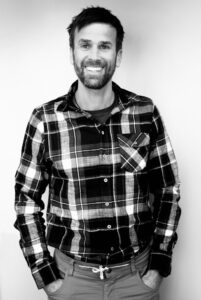
↑ Jörg Randl after the interview with analyse:berg
Photo: argonaut.pro
The mountain sports department of the Austrian Alpine Club has had a new head since December 1, 2024: Jörg Randl. The 42-year-old Tyrolean’s career to date is impressive:
Even at a young age, the then enthusiastic climber was a member of the Hohe Munde section of the Alpine Club. This period also saw his first experiences in competitive sports– in sport climbing, where he competed both nationally and internationally in European Cup and Youth World Championships. was successful. Jörg was also successful in mountain running, with the Mountain bike and road bike on the TransAlp race, Ötzvalley marathons and so on. Also at the ski mountaineering which was created for competition at the time. Two heavy Injuries ultimately thwarted his further rise to the international elite.
Time, therefore, to complete alpine training courses, such as Sport Climbing Instructor I and II, as well asthe entrance examination for the gendarmerie inparallel with the army, whose training he graduated in 2005. At the Imst and Axams police stations continued with the special alpine training to become an alpinist, high alpinist and police mountain guide, and in between with the sport climbing instructor for popular sports and the civilian mountain guide.
Jörg has been the head of the Alpine Emergency Group (AEG) in the Innsbruck Land and City district since 2018. In 2019, he trained as an air rescuer and has spent the last few years flying the “Libelle” police helicopter from the Innsbruck base in the field. He is currently still the trainer for general and special climbing training, which he wouldnow like to completealongside his new job at the Alpine Club, as well as the final moduleto become a competitive sport climbing instructor.
Since childhood, Jörg’s life has revolved around the mountains, something that he now experiences and passes onin his free time with his wife and son.
We asked him why he is now leaving police work behind, why he applied to become head of the mountain sports department at the Alpine Club and how he would like to shape his future and that of the ÖAV mountain sports department in this position .
a:b
With your affinity for mountaineering, yourbackground as an AEG leader and your experience as a flight operator with the Libelle, one question comesto mind: Why did you switch to the Alpine Club?
JR
I’ve been asked this question a lot recently. answer is: For many years I have attended accidents accidents, recorded them, documented them and summarized them, usually with a final report.to the public prosecutor’s offices. I have seen The tragic way in which alpine accidentshave ended, even in terrain where this is hardly to be expected. possible. The accident survey and the report and then comes the next assignment and the next and the next. So there is no time to consider where we could help, what adjustments could be made or what impetus could be given so that one or two accidents could be avoided or would end less tragically .The police don’t have time for prevention work, even if they do have time to fill the alpine accident statistics. supporting role in drawing conclusions. More but it is not.
When the managerial position in the mountain sports department of the Alpine Club was advertised, I saw a great opportunity for me to great opportunity for me to help shape the development the development of the various mountain sports disciplines and in particular to become more active in the area of safety. in the area of safety.
a:b
You have many accidents with serious injuries and fatalities. people seen. Has that increased your enjoyment of the mountain? sport not spoiled?
JR
No, on the contrary. As tragic as accidents often end, they can also be very instructive, because you can see how quickly something can happen and how worthwhile it is to deal with safety issues, draw conclusions for yourself and hopefully learn from them. Particularly in the case of incidents involving a seriously injured or perhaps even deceasedperson, my aim has always been to process and document them so well that the course of events leading up to the accident is comprehensible to everyone and that it is also easier for the bereaved to process the situation. becomes more tangible in a certain way. Above all also for the relatives who have little to do with “Berg”. mountain, I also saw this as a way of supporting theirprocessing.
a:b
Today, there are numerous initiatives and organizaorganizations offer so many training courses on all alpine Topics like never before. Is this going in the right direction? or are you thinking – especially now at the beginning of your new Activity – that something is still missing here? Are you planning in the new, different focal points in the training courses, or is is everything going well at the ÖAV as it is?
JR
That’s not an easy question, because many people have already many people have already racked their brains and tried to and have tried to pass on the information in the best possiblethe best possible way in the various types of course.
Nevertheless: You can train people, you can support them, you can create offers, but centrally you have topersonal responsibility. Nowadays care must be taken not to overwhelm people with the wealth of and information – including in digital form – not to to oversaturate, to overtax. I am thinking, for example, of the Tour planning and realistic self-assessment. In other words, don’t let yourself be led by 100,000 posts and videos.and videos, but to be clear and honest with yourself and ask yourself: “Is this really something for you? me? Do I correspond to this tour in every way? Do I really have enough experience?” I would like to take a closer look at this topic . You should also keep up with the times. Trail running and speed hiking are mountain sports disciplines that are becoming increasingly popular and need to be considered.
“You can train people train them, you can support them,
one offers can be created, but centrally you have to
always remainresponsibility.”
a:b
The great thing about mountaineering is that it’s easy. You can do great tours with little effort. There are a few important rules that help me to assessalpine dangers. After that, however – especially when it comes to avalanches – you immediately enter a very scientific area, which is undoubtedly exciting, but often not very helpful for me in practice.
During training, we as mountain guides are often faced with the question of what and how much we should pass on. There are two directions here: Even more and more precisely and preferably one more online training course or, above all, to go out and gain experience ourselves with simple assistance . Which is your direction?
JR
I am of the opinion that you need a good foundation of knowledge. If that starts with any where attending an online module or sitting in on a class is fine – you have to start somewhere. But the most important thing is to learn and practise the necessary skills outdoors. Forexample , thefirst few minutes of searching for avalanche transceivers, probing, shoveling and first aid are crucial when rescuing comradesafter an avalanche . Even though today an emergency call can be made quickly and efficiently using a cell phone , your figures also show that this comrade assistance must work on site in order to keep the chances of survival of a buried victim high. And I have to be good at this, I have to be good at it in the practice under stress. I can I need to read up on the subject, yes, but above all I need to gain experience, I need to be able to assess the situation on the ground and be able to act.
But it’s not only in an emergency situation that I have to remain flexible in terms of my head, e.g. also in the Tour planning. So don’t stick stubbornly to plan A, but know that there are days that make a plan B or C necessary – or that the plan can only be implemented in the first place. to turn around and go home. The Outdoor practice is therefore very relevant and very important.
a:b
There are also two opinions on this: Some demand that every mountaineer makes his own decisions based on his knowledge, ability and experience.tion. Others are convinced that rules, algorithms and AI are superior to humans on the mountain. This then culminates in discussions about whether someone who strictly adheres to recommendations, forecasts and calculations is legally and morally off the hook in the event of an accident because they have followed all the guidelines.
JR
In my opinion, it is first and foremost important to empto have guidelines. In the case of rules and guidelines often the danger that people will then be interested in precisely which is not permitted. In any case, it needs the Opportunity to gain information. However, the question is how much information people are actually provided with. can handle. Today you read the text to the avalanche report, then the text on the weather forecast, then tour descriptions or in an online portal like the conditions five days ago were. I wonder how much people are actually able to can work. What they can store and know then in the field they really still see what is everywhere was inside? For planning from home find I think valid and up-to-date information is important. But out on the ground, I have to be attentive myself, because, for example, the snow situation is different from what was described and forecast.
The task here is then to information with his knowledge, skills and experience experience into practice, i.e. in the field. to make his decisions. Relying only on rules and believe that it is “safe” to be on the road. I don’t think it’s a good idea.
a:b
Have some mountaineers lost their self-confidence – or don’t even know – that they can make such forecasts and rules are allowed to overrule? According to the motto: If the weather forecast says it’s raining, then I walk around with an umbrella umbrella, even if it’s not raining at all.
JR
That’s how I see it too: you have to find out for yourself on site. Take a picture. This is the only way to grow and learn, no matter what decision that leads to.
a:b
The Alpine Club has been successful in the last few years. there has been a steady increase in membership. Mountaineering has meanwhile become a popular sport and the ÖAV Alpine Department was renamed the Mountain Sports Referenamed the Mountain Sports Council.
Malicious tongues claim that the Alpine Club is now there for everything except the mountains.rise. Is it your goal to serve the members like this? that they have the opportunity to develop into independent mountaineers mountaineers or does it correspond to today’stime to convey to all those hungry for exercise that that they should stick to the rules and be defensive on the should be defensive?
JR
If you call it “servicing”, then it is the answer is “both”. If people like to go to the Going up mountains – in whatever mountain sports discipline, whether hiking, climbing or ski touring – and want to want to try it out for the first time, then you should basic knowledge. These must The information should be well presented in simple language so that they can absorb and utilize it . They should then gain more and more experience during Alpine Club tours.
All in all I see it as our task to support people so that they support them so that they can continuously achieve more independence parallel to their respective level of education and thus also honestly and realistically assess themselves.can appreciate. In any case, they should get that far, to know which tours they go on alone and which difficulties they can face. And consequently which undertakings exceed their knowledge and for which it is better to choose a guided Alpine Clubtour or book a mountain guide.
So it should go both ways: To provide basic knowledge and thus enable a good start, but also to offer the opportunity to achieve independence or even get to the point of recognizing when others need help and being able tohelp accordingly .
“You can only pass on pass on,
what you really understood understood.”
a:b
What role do the sections play in training and what role does the main association play?
JR
The main association should provide the tools, as it already does with the “Safe on the Mountain” tools, for example. The section is then the direct point of reference for members, who often gain their first experience of mountain sports there . collects. We therefore need competent and motivated Tour guides, good alpine instructors and a wide range of activities in the section in order to be able to offerthe various mountain sports areas at the right time – depending on the season.
For example, members should have the opportunity to book a course or an update on how to use emergency equipment at the start of the winter season – perhaps combined with a short off-piste tour including hairpin bend technique to be able to. Between the main association and the alpine departments and the tour guides, a good exchange must be guaranteed. The aim of the mountain sports department must be to serve the sections as well as possible, to provide them with good documentation that they themselves understandso that they can pass on the content. After all, you can only pass on what you really understand yourself.
a:b
So it’s about being authentic. As a tour guide , I don’t have to know exactly how the electronics of the avalanche transceiver work, I have to be able to communicatehow to use them well . Not “We are the show”, but teaching the members skills that they need and with which they can work well outdoors?
JR
As a teacher in the Alpine Police training program, for examplepolice, for example, I always insisted that every can lay a prusik with a cord. I was It is important that you know how to use the basic tools.can do. Then you can build on that and see, what other knots and clamps are available, what the advantages and disadvantages and what is best for my purpose is just the best. I should always, as be already mentioned, can remain elastic to the situation. One Basic technical information about the avalanche transceiver, e.g. frequency or the 3-antennae, I should have heard once, yes. But then it is important that I know how to operate my device, that I know how to use my device in an emergency. act in the best possible way. And, of course, that I can use the emergency number, how to start the search efficiently alone or with my group efficiently start the search, etc. I am in favor of simplicity, as long as it is communicated well and correctly andapplied correctly.
a:b
Anyone can lead a tour in a section, there are nono mandatory training for this. On the other hand there are numerous training opportunities from the up to the instructor. Is it your wish that every tour guides receive the best possible training or does it work well in the section? if the experienced ones are also out and about with with others without formal training?
JR
It is now the case that, as a tour guide, you have to practicemust be a tour leader. Those who have been tour guides for a long time were credited to them. The fact that the tour guides have any training, at least that’s what important. Firstly, their content should not be limited to the They haveto be able to pass on not only theory, but also practical experience– and that is only possible if they have undergone trainingthemselves .
Apart from that, I see this in a wider context: if someone is training to become an instructor at the Alpine Club today , they may also want to complete an instructor training course and develop their skills. further. Perhaps this will end with one or the other Also – although this is not the aim of the Alpine Club – in mountain guide training. Or someone develops an interest in mountain rescue or vice versa: someone who is active in mountain rescue but has not previously been with the Alpine Club becomes interested in becoming a ski tour instructor. All in all, I see this as a win-win situation and hope that all training courses ultimately benefit from each other.
“I am in favor of simplicity, as long as this
well and correctly applied correctly.”
a:b
Wouldn’t it then be desirable that thistraining courses are all constructive? That you don’t always the same content over and over again, but courses are credited against each other – in other words, a modular, progressive alpine training system?
JR
You could certainly think about that. One aspect is certainly the time aspect: If someonedoes an instructorand then is no longer active for 15 to 20 years, I could imagine that something could happen again. expires. But otherwise, for example, if you look at the police and the civilian mountain guide, then there are very well certain courses are credited. Courses to be credited are therefore certainly a consideration that can be actively discussed – also in terms of the time involved. I am not a fan of having too much time between the individual courses because, after all, the wheel keeps turning.keeps turning.
a:b
In some large sections, the voluntary work of the leading to some extent very exhausted. While smaller local offer training and tours for their members almost free of their members, large sections charge the same prices charge the same prices for the services of their tour guides like alpine schools that only use mountain guides. See and where in the Alpine Club is the boundary between the boundary between voluntary and professionalprofessional leadership?
JR
I’m not going to answer that question, although of course I know what you’re talking about. Generally speaking be and remain voluntary. I also believe that the volunteer-run services offered by sections should be clearly different from the services offered by mountain guides and alpine schools.
“Everyone has their training with which they should do,
what he is allowed to do with it. No more and nothing less.”
a:b
You can also join forces, there are good opportunities andand examples of volunteer and professional guides traveling together. professional guides are out and about together.
JR
I agree, there is not just one way. Of course, I can, for example, offer a touring week with two instructors or two instructors with one or two additional mountain guides. But in terms of differentiation, it has to be clear that everyone does what they are allowed and able to do. You can’t mix things up and there shouldn’t be any tension. field. No one should want to be more than He actually is and regardless of whether you are called a tour guide, tour leader or guide – which is debatable – it must not happen that a third person from outside can no longer distinguish this tour leader from the mountain guide.
Everyone has their own training, which they should use to do what they are allowed to do. No more and no less. And the highest level of training is the mountain guide.
a:b
You often hear that mountain guidesare under a lot of pressure, which influences their risk decisions. Do you know this and does it also apply to the tour guides of the sections?
JR
The sections should offer a realistic range of tours that matchthe level of training of the tour guidesthey employ. That may sound a bit police-like, but it also means that the tour content and difficulties are adapted. Under no circumstances should programs be developed where the tour guides themselves already have a stomach ache. As a full-time mountain guide, however, you naturally want to try to have a full workload each season.
As far as risk is concerned, I can say personally and from my perspective as a mountain guide that I have never had a problem with had self-made pressure. If the conditions outside no longer fit and doubts arose, then I made a decision accordingly. How this works for I find it difficult to answer the question of what each individual does. In general, however, I do believe that the mountain guides are far-sighted enough to know that they don’t necessarily always have to deliver. I think everyone tries to do the best they can in the respective conditions. Nobody deliberately takes risks, that are no longer justifiable. Nobody wants anything happens or that you can no longer get home.
a:b
The tour guides do a very good job, as the low accident figures alone show. Does the Alpine Club have problems recruiting new volunteer guides?
JR
We receive reports in the department about who which training courses are offered. Here we can clearly see that especially the instructor of the various mountain sportsdisciplines is very popular. I think it is important to work with the tour guides and those who become tour guides want to work well together. If you have someone If you have someone in your group who shows potential and interest, you could actively approach this person and ask them whether they would be interested in training to become a tour guide. So it’s not a case of “forcing them”, but perhaps a case of “tantalizing them”.
Subsequently, this person could certainly besupported a little, in terms of training, but also in terms of materials, clothing or whatever, so that they feel valued in this valuable activity that they carry out on a voluntary basis.
a:b
Since we’re talking about training: there are variousthe doctrines of various institutions. In However, recently there has been a lot of discussion within the Alpine Club. difficult to recognize a uniform line here.
Z. For example, the ÖAV teaches integrative avalanche awareness in its instructor courses and Stop or Go in other training courses . Can one institution also represent two very different doctrines or should the aim be to come to a consensus?
JR
I’m not going to answer that either. We have our Thoughts from the department. But I think you should start with the basics in terms of teaching, offering people a kind of basic training on the subject of risk assessment , to give them the basic tools of the trade. Then But if it continues in the form of instructor training, the aim should be to give them even more knowledge and also to teach them more in application. convey. If you are referring to these two examples, then the integrative approach should definitely be included in instructor training : in planning, in the assessment of the terrain and the individual slope and then in reflection as well. I definitely support rethinking a teaching opinion , but people also have to find an entry point somewhere .
“I see my work as teamwork:
Every employee employee grows,
when thinking along is possible.
co-design motivated.”
a:b
Your new job sounds suspiciously like a desk job. In your previous job as AEG manager of the Alpine Police, you spent a lot of time outdoors. Does it stress you out that you have to sit in front of a computer more and do a lot of administrative work with your colleagues, or do you see the association’s work with its many meetings as a challenge?
JR
Yes, there are lots of sessions. But I also work as a trainer for the Academy – not during working hours, but in my free time. Or even when videos are produced, we watch them outside on location with the people. I don’t see that now from my office job not quite so problematic, especially given the fact that it’s a 40-hour job.
In the police it’s often the case that there are a lot of hours, often more than 40 in a week. And as head of AEG , you ‘re not just outside all the time, you also have to do a lot of office work, such as reporting, submissions, etc. – that’s the work in the background that you don’t see immediately . As head of department, you also have to attend meetings, exchange ideas, sit in front of the computer and meet deadlines, which is part of the job and doesn’t stress me out.
a:b
If you were to think five or ten years ahead, what would you like to accomplish as head of the Alpine Club’s mountain sports department?
JR
I am currently still learning the ropes. One goal is However, even if it cannot be measured directly, it is important to be able to help shape developments in such a way that one or two serious or even fatal accidents can actually be avoided.
a:b
Is mountaineering allowed to be dangerous, can people be injured and die in the process, or is every alpine accident one too many?
JR
When people are out and about on the mountain, it’s always accidents, there will always be a residual risk. Whether Whether mountaineering is dangerous also depends on the difficultyof the tour, the current conditions or other factors. influencing factors. I do think that mountaineering always harbors a certain danger due to this residual risk. Apart from that, there is personal responsibility and everyone is allowed to determine their risk in any way they wish.lay. So if someone wants to free solo climb a 500-meter wall as his or her goal, then he or she may may do so – even if the consequence of failingor breaking out of the handle will be fatal. Such There will always be people, no matter how many concepts concepts and training courses.
a:b
How important is the exchange and networking with other with other associations and organizations in order to stand? Or has the Alpine Club, as the largest Association also has the greatest expertise here?
JR
That is very important to me. I currently have a lot of appointments, so I don’t have much time for networking at the moment. But of course I am of the opinion that the needs a good exchange of ideas. I insist on all However, it is important that this exchange is honest and open and not aimed at any advantage or anything else. If you represent something to the outside world, then it should be coordinated and have a consistent line.
a:b
Can people argue with you about things and the one who the better arguments wins?
JR
Yes, I do believe that. If the arguments are good, But it can happen that at a certain point say nothing more. But that has to do with the fact that I then try to be reflective and see the whole situation once again. If it is a tense interpersonal situation, I try to understand this as a third, outside person. see. Everyone should have a say in technical discussions and be allowed to put forward his arguments. I see that This is also the case within the department. It should be a “we”, where we can exchange ideas and everyone can have their say. Under no circumstances do I want something to be done behind the and then be presented with a fait accompli. before a fait accompli.
In any case, I see my work as teamwork: Every employee grows when a Thinking along is possible. Co-creation motivates.
The interview was transcribed by Christina Schwann.
This interview was published in the winter 2024/25 issue of the ÖKAS trade magazine analyse:berg, which is hot off the press!
Become a subscriber to analyse:berg. You will receive the magazines conveniently delivered to your home as soon as they are published and support the work of ÖKAS at the same time.
Links & Publications:
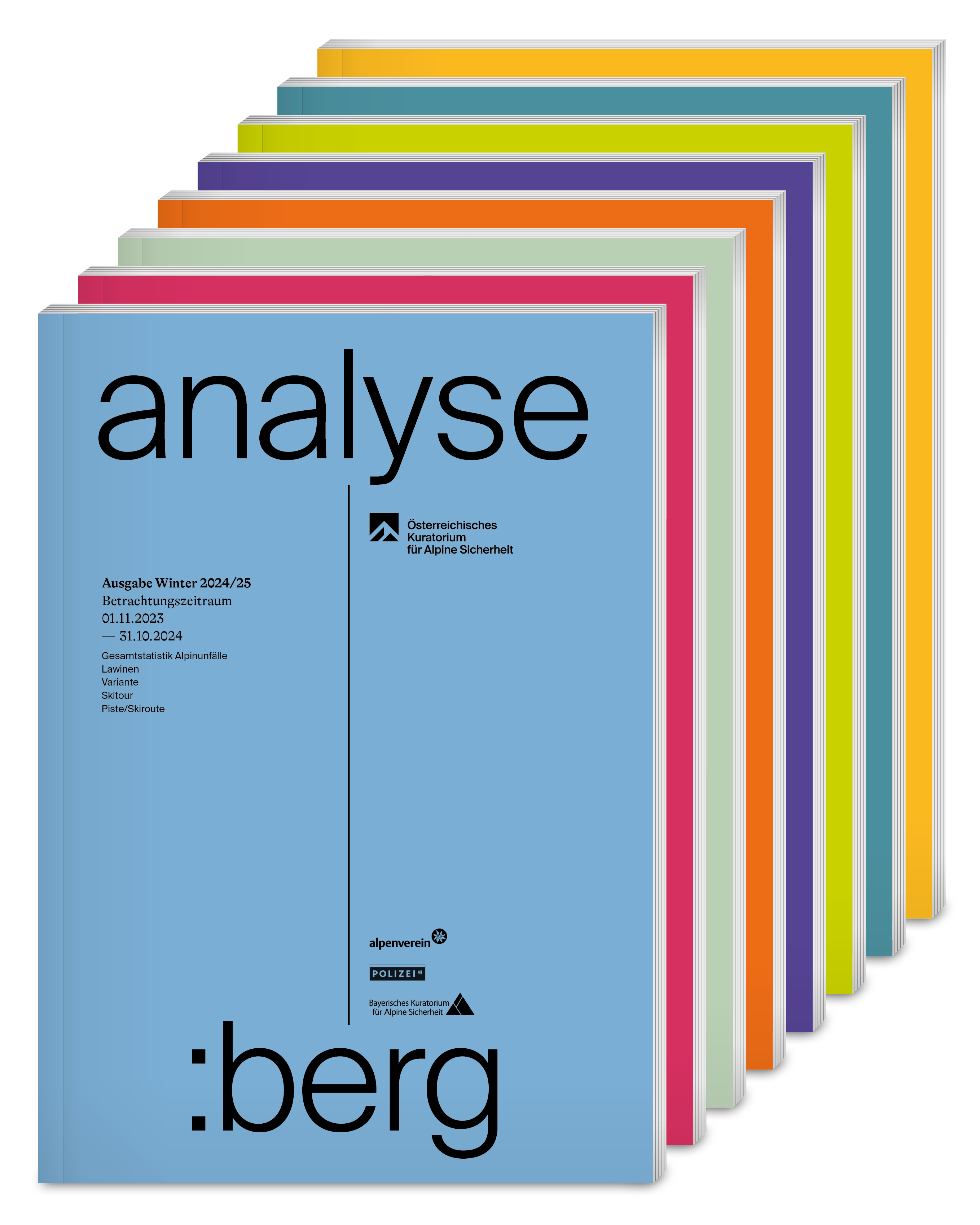
- This article is published in the ÖKAS trade magazine analyse:berg Winter 2024/25 (observation period: 01.11.2023 to 31.10.2024).
- Editor-in-chief: Peter Plattner(peter.plattner@alpinesicherheit.at)
- Subscription magazine analyse:berg Winter & Summer
- Alpine Primer Series of the Board of Trustees
- Alpine Fair / Alpine Forum 2024
- Contact ÖKAS:
Susanna Mitterer, Austrian Board of Trustees for Alpine Safety, Olympiastr. 39, 6020 Innsbruck, susanna.mitterer@alpinesicherheit.atTel. +43 512 365451-13

